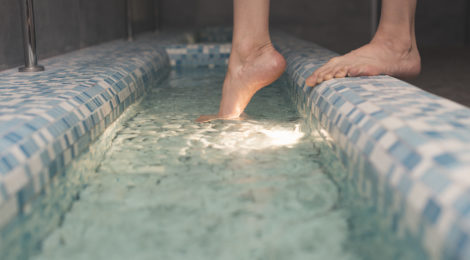
Ice Baths for Mental Health Show Promise
The growing trend of “cold water immersion” – immersing yourself in ice baths or taking cold showers – is promoted as providing physical and mental health benefits. Most prior research has focused on physical health benefits.
But emerging research is also starting to show that ice baths can help mental health by causing physiological changes in the brain and body, and through psychological impacts of being in the stress of cold water.
Several studies show mood improvements immediately after and 30 minutes after cold water immersion, with significant improvements in self-esteem and depression ratings. One study even found that after a cold bath, not only did participants feel more alert, proud, inspired, and less distressed and nervous, but their brain scans also showed improved activity. In one case study, a woman with major depressive disorder and anxiety no longer had symptoms after four months of cold water swimming, eventually discontinuing medication and remaining symptom-free a year later.

Research is showing that ice baths increase neurotransmitters that may help improve depression and anxiety. Depression is associated with low levels of the neurotransmitters dopamine and norepinephrine. Dopamine enhances goal-directed behaviour, mood, motivation, and focus. Norepinephrine increases energy and focus, while contributing to the sleep-wake cycle, mood, and memory. A study showed that after a cold bath, dopamine levels increased by 250%, which lasted 2 hours later. Even more notable, norepinephrine levels increased by 530%. Given that SNRI medications for depression and anxiety also aim to increase norepinephrine levels, ice baths may help depression and anxiety. As well, it is possible that ice baths improve depression through an anti-inflammatory process.
Ice baths also may help calm the nervous system of people with PTSD or a history of trauma, depending on the individual. In an interview with Will Cronenwett, Chief of Psychiatry at Northwestern University School of Medicine, he explains that while ice baths temporarily increase sympathetic nervous system activity – the “fight or flight” response, cold water on the face and neck stimulates the parasympathetic nervous system – the “rest or digest” system that makes people feel calm.
Heather Edgell, Associate Professor in Kinesiology and Health Science at York University, points to evidence showing that cold water immersion increases “rest or digest” activity, which is why many people feel calmer from ice baths. In fact, applying cold on one’s face reduces acute psychological stress by stimulating this “rest or digest” system, which is why applying ice is widely used as a distress tolerance strategy.
From a psychological perspective, Andrew Huberman, Associate Professor of Neurobiology and Ophthalmology at Stanford University, explains in his podcast that ice baths can help people train their brain to stay calm when stressed. This can build resilience and grit for when they experience other life stressors.
In fact, Cronenwett says, “I think the main mental health benefits of cold water immersion are psychological… It can be scary, so when you are doing it, you are overcoming your fear. This feels good, like mastering any difficult feat.”

Anna Lembke, Chief of the Addiction Medicine Dual Diagnosis Clinic at Stanford University, and author of New York Times best-seller Dopamine Nation: Finding Balance in the Age of Indulgence, suggests doing graded exposure of ice baths by starting with a warmer temperature and shorter time and observing each person’s reaction. She says that “many patients with chronic pain and mental health conditions feel better after graded exposure to ice baths, but I have had some patients who reacted negatively and to whom I recommended either not continuing or starting with smaller doses.”
Ice baths may also be useful for people with addiction, which Lembke has found clinically. She explains that the increases of dopamine and norepinephrine from ice baths give people temporary relief from depression, anxiety, and withdrawal from addictive substances and behaviours. Huberman explains in his podcast that the long-lasting dopamine release from ice baths is healthier than short bursts of dopamine that occur with addiction.
So how cold does the bath really need to be? Mark Harper, author of Chill: The Cold Water Swim Cure, points to his research showing that ice baths are effective for anxiety and depression, and that the maximum response occurs between 10°-15°C, with no further significant effect below 10°C.
And what about safety? Cronenwett advises those with pre-existing cardiac, pulmonary or mobility conditions to consult their doctor regarding safety. Since ice baths are only done for seconds or up to a few minutes, hypothermia doesn’t seem to occur. The most well-known protocol shows that the health benefits of ice baths occur when done for 11 minutes or more altogether throughout the week, which can be divided into 2-3 minutes or less each time.
So… are you ready to take the plunge?
– Lauren Rudolph, Contributing Writer and Senior Editor
Image Credits:
Feature: Freepik, Creative Commons
First: Erik Dungan at Unsplash, Creative Commons
Second: PikiSuperstar at Freepik, Creative Commons



